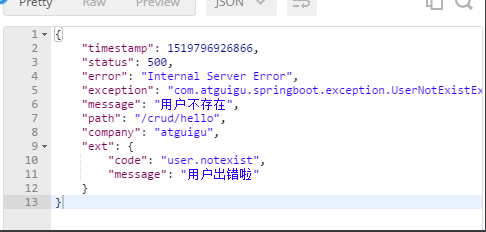浏览器发送的请求头:

如果是其他的请求方式,比如客户端,则相应一个json数据:


原理;是通过
帮我们在页面共享信息; @Override public Map<String, Object> getErrorAttributes(RequestAttributes requestAttributes, boolean includeStackTrace) { Map<String, Object> errorAttributes = new LinkedHashMap<String, Object>(); errorAttributes.put("timestamp", new Date()); addStatus(errorAttributes, requestAttributes); addErrorDetails(errorAttributes, requestAttributes, includeStackTrace); addPath(errorAttributes, requestAttributes); return errorAttributes; }
@Controller @RequestMapping("${server.error.path:${error.path:/error}}") public class BasicErrorController extends AbstractErrorController { @RequestMapping(produces = "text/html")//产生html类型的数据;浏览器发送的请求来到这个方法处理 public ModelAndView errorHtml(HttpServletRequest request, HttpServletResponse response) { HttpStatus status = getStatus(request); Map<String, Object> model = Collections.unmodifiableMap(getErrorAttributes( request, isIncludeStackTrace(request, MediaType.TEXT_HTML))); response.setStatus(status.value()); //去哪个页面作为错误页面;包含页面地址和页面内容 ModelAndView modelAndView = resolveErrorView(request, response, status, model); return (modelAndView == null ? new ModelAndView("error", model) : modelAndView); } @RequestMapping @ResponseBody //产生json数据,其他客户端来到这个方法处理; public ResponseEntity<Map<String, Object>> error(HttpServletRequest request) { Map<String, Object> body = getErrorAttributes(request, isIncludeStackTrace(request, MediaType.ALL)); HttpStatus status = getStatus(request); return new ResponseEntity<Map<String, Object>>(body, status); }
@Value("${error.path:/error}")
private String path = "/error"; 系统出现错误以后来到error请求进行处理;(web.xml注册的错误页面规则)
@Override public ModelAndView resolveErrorView(HttpServletRequest request, HttpStatus status, Map<String, Object> model) { ModelAndView modelAndView = resolve(String.valueOf(status), model); if (modelAndView == null && SERIES_VIEWS.containsKey(status.series())) { modelAndView = resolve(SERIES_VIEWS.get(status.series()), model); } return modelAndView; } private ModelAndView resolve(String viewName, Map<String, Object> model) { //默认SpringBoot可以去找到一个页面? error/404 String errorViewName = "error/" + viewName; //模板引擎可以解析这个页面地址就用模板引擎解析 TemplateAvailabilityProvider provider = this.templateAvailabilityProviders .getProvider(errorViewName, this.applicationContext); if (provider != null) { //模板引擎可用的情况下返回到errorViewName指定的视图地址 return new ModelAndView(errorViewName, model); } //模板引擎不可用,就在静态资源文件夹下找errorViewName对应的页面 error/404.html return resolveResource(errorViewName, model); }
一但系统出现4xx或者5xx之类的错误;ErrorPageCustomizer就会生效(定制错误的响应规则);就会来到/error请求;就会被BasicErrorController处理;
protected ModelAndView resolveErrorView(HttpServletRequest request, HttpServletResponse response, HttpStatus status, Map<String, Object> model) { //所有的ErrorViewResolver得到ModelAndView for (ErrorViewResolver resolver : this.errorViewResolvers) { ModelAndView modelAndView = resolver.resolveErrorView(request, status, model); if (modelAndView != null) { return modelAndView; } } return null; }
我们可以使用4xx和5xx作为错误页面的文件名来匹配这种类型的所有错误,精确优先(优先寻找精确的状态码.html);
页面能获取的信息;
timestamp:时间戳
status:状态码
error:错误提示
exception:异常对象
message:异常消息
errors:JSR303数据校验的错误都在这里
2)、没有模板引擎(模板引擎找不到这个错误页面),静态资源文件夹下找;
3)、以上都没有错误页面,就是默认来到SpringBoot默认的错误提示页面;
如何定制错误的json数据;
Controller.MyExceptionHandler
package com.project.javasystem.Controller; import com.project.javasystem.exception.UserNotExistException; import org.springframework.http.HttpRequest; import org.springframework.web.bind.annotation.ControllerAdvice; import org.springframework.web.bind.annotation.ExceptionHandler; import org.springframework.web.bind.annotation.ResponseBody; import javax.servlet.http.HttpServletRequest; import java.util.HashMap; import java.util.Map; @ControllerAdvice public class MyExceptionHandler { //方法一: //浏览器,客户端都返回的是Json数据 /* @ResponseBody//响应json数据 @ExceptionHandler(UserNotExistException.class) public Map<String,Object> handleException(Exception e){ Map<String,Object>map = new HashMap<>(); map.put("code:","User.notExit"); map.put("message:",e.getMessage()); return map; }*/ //方法二:自适应效果 @ExceptionHandler(UserNotExistException.class) public String handleException(Exception e,HttpServletRequest request){ Map<String,Object>map = new HashMap<>(); //传入自定义的状态码 /*Integer statusCode = (Integer)request.getAttribute("javax.servlet.error.status_code");*/ request.setAttribute("javax.servlet.error.status_code",500); map.put("code:","User.NotExit"); map.put("message:","用户出错啦"); //转发到error进行自适应处理 request.setAttribute("MyError",map); //转发到error return "forward:/error"; } }
出现错误以后,会来到/error请求,会被BasicErrorController处理,响应出去可以获取的数据是由getErrorAttributes得到的(是AbstractErrorController(ErrorController)规定的方法);
1、完全来编写一个ErrorController的实现类【或者是编写AbstractErrorController的子类】,放在容器中;
2、页面上能用的数据,或者是json返回能用的数据都是通过errorAttributes.getErrorAttributes得到;
容器中DefaultErrorAttributes.getErrorAttributes();默认进行数据处理的;
自定义ErrorAttributes
Component.MyErrorAttributes
package com.project.javasystem.Component; import org.springframework.boot.web.servlet.error.DefaultErrorAttributes; import org.springframework.stereotype.Component; import org.springframework.web.context.request.WebRequest; import java.util.Map; @Component public class MyErrorAttributes extends DefaultErrorAttributes { //返回值 map中就是页面和json能获取的所有字段 @Override public Map<String, Object> getErrorAttributes(WebRequest webRequest, boolean includeStackTrace) { Map<String, Object> map = super.getErrorAttributes(webRequest,includeStackTrace); map.put("CompanyName","517NA"); // 异常处理器携带的数据 Map<String,Object>MyError = (Map<String, Object>) webRequest.getAttribute("MyError", 0); map.put("MyError",MyError); return map; } }
最终的效果:响应是自适应的,可以通过定制ErrorAttributes改变需要返回的内容,

